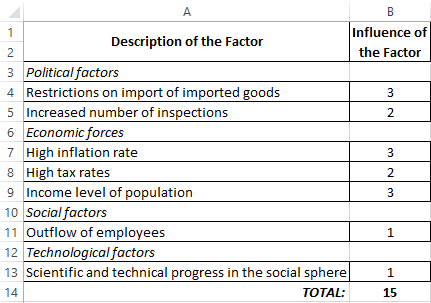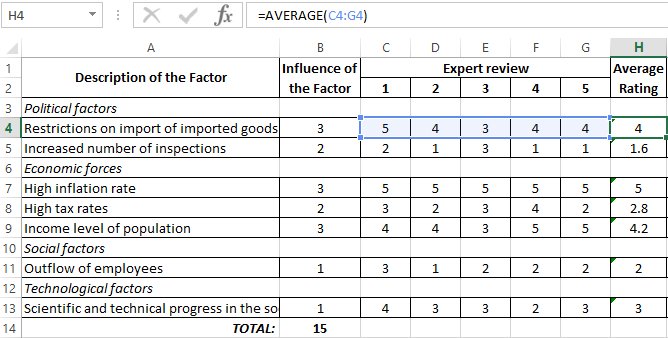Macro analysis using pest analysis in Excel with example
PEST-analysis is a marketing tool for identifying various aspects of the environment that affect or can affect the enterprise business. Explanation of the abbreviation factors: P - Political, E - economic, S - social, T- technological.
Essence and use of PEST analysis
PEST-analysis is a method for studying the macroeconomic environment. The abbreviation contains the following components:
- Policy. The political system and the stability in the country affect the enterprise business activity. Legal acts establish norms of relationships in the business environment. The activities of any company should be carried out within the framework of legislation.
- Economy. The rates of inflation, interest rate, exchange rates, unemployment, and wages, etc. are studied with the help of this analysis component. Economic indicators determine the level of prices, profitability and client’s solvency.
- Social component (consumer preferences and opportunities). This includes traditions and society values, ethical norms, tastes, lifestyle, etc.
- Technological component. These factors are studied in order to find new trends in technological development that will help modernize equipment, create a new product and improve the production process.
The analysis is carried out according to the "factor-enterprise" scheme. The results are entered in the matrix where the subject is factors, and the predicate is the force of impact in points, ranks, and similar units.
PEST analysis of external environment factors in Excel
The set of factors in each group will be individual. It depends on the scope of the enterprise, the characteristics of the region, the purposes of analysis.
At the first stage, we compile a list of factors that can affect the company's profit in the long run. In the literature you can find such examples:
| Political factors: |
|
| Economic factors: |
|
| Social factors: |
|
| Technological factors: |
|
The example of a PEST-analysis of trade enterprise:
- Political factors. Part of the production in the store "X" came from foreign suppliers. Restrictions have been introduced due to the policy of sanctions on a number of goods Therefore, the director had to look for substitute products (analogs) in the domestic market and from producers from the Customs Union countries. The policy of sanctions also led to an increase in the number of various inspections by the supervisory authorities. As a result, administrative and corruption costs increased.
- Economic factors. A high rate of inflation led to a depreciation of savings. The increase in tax rates led to an overstatement of costs and price increase.
- Social factors. The increase in the mobility of the population led to a "turnover" of the staff. The way out is to improve the system of labor incentives.
- Technological factors. Scientific and technological progress in the social sphere has led to an increase in the level of the population needs.
Now we have to determine the factors. Then experts assess the strength of influence of each of them. The scale is from 1 to 3.

Next, you need to assess the probability of changing the factor. The scale is from 1 to 5. The evaluation is best to engage several experts with some working shop experience.

The arithmetic mean is estimated using the AVERAGE function.
Next, you need to assess the real significance of each factor. This will make it possible to find out how much attention and control should be paid to this or that factor.

The higher the weight-corrected score, the more attention should be paid to neutralizing this factor.
Next, we need to give the calculations a matrix form. Factors need to be arranged in descending order.

Download example pest analysis
Conclusions are drawn based on this PEST-analysis table: the influence of their factors prevents the maximum profit, how to reduce the negative impact.
